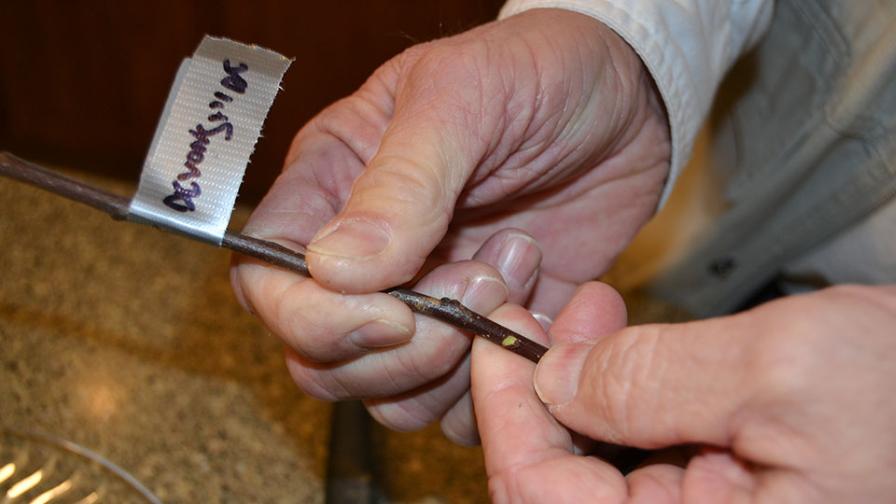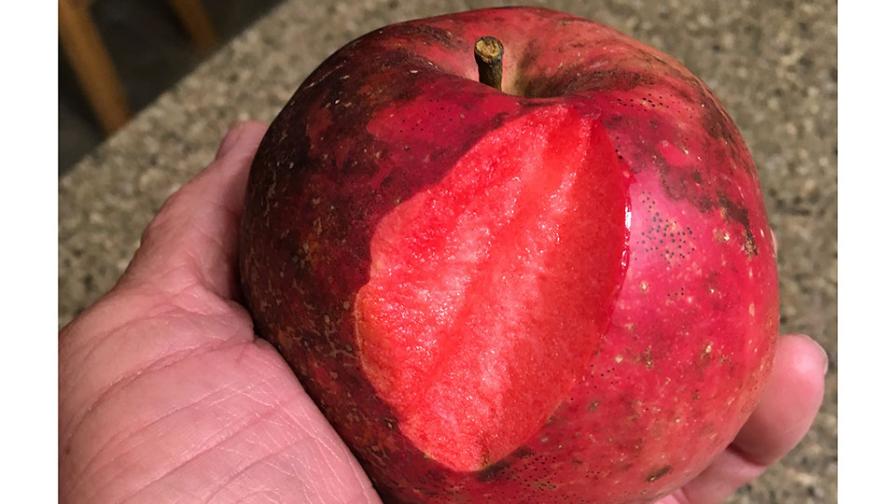All Hail the Apple Scion King

Derek Mills, the owner of Hocking Hills Orchard at Four Seasons Cabins, cuts up to 2,000 apple tree scions every year. The scions are then sold, traded, or donated.
Photo by Thomas Skernivitz
Fittingly, it all started with George Washington. The year is 1983, nearly two centuries after the inauguration of our nation’s first president. A 20-something budding apple grower named Derek Mills is reading a magazine story about a guy who has just singled out George Washington’s favorite variety — ‘Newtown Pippin’.
“I thought to myself, ‘How does he know?’ So, I write him a letter, which people did back in the day,” Mills says. “The guy writes me back, and he tells me about the one of the greatest groups — the North American Fruit Explorers.”
NAFEX is comprised of men and women who prevent old and unusual varieties of fruit from dying out.
Better yet for Mills, the man mails him a ‘Newtown Pippin’ scion along with a rootstock.
“And he sends me a little note. He goes, ‘This is how you graft.’ I remember thinking to myself, ‘This will NEVER work.’ But I did it,” Mills says. “I followed his instructions, and it worked, and I was shocked. All of a sudden, I’ve got ‘Newtown Pippin’ growing. I thought, ‘How cool is that?’ So, I wind up joining the group.”
Following George Washington, Mills logically turned to Thomas Jefferson and his favorite apple. Faster than he could say ‘Esopus Spitzenburg’, Mills was then focusing on Ben Franklin.
“So, now I’m hooked,” Mills says. That’s what they say: It’s an easy thing to get hooked on. That’s what started it. One thing led to another.”
MAKING HISTORY
These days, “another” has graduated to more than 1,700 different varieties of apple — every one of them contained at his and wife Lisa’s 8-acre residence in Logan, OH, 48 miles southeast of Columbus. Their farm, Hocking Hills Orchard at Four Seasons Cabins, is “probably the most mom and pop thing you could possibly go to,” Mills says.
Pick-your-own customers are welcomed on select dates during the harvest season. They will find each of the 12 varieties that currently comprise 98.5% of all apples grown in North America — an “astounding” figure, Mills says — but they won’t find many of them. Instead, that valuable space is dedicated to many of the 2,500 varieties that were commercially available in the 1800s but, for the most part, are now missing in action.
“I’m not like a big commercial orchard,” Mills, 63, says.
That much became obvious a few years ago during a conversation with Mitch Lynd, winner of the 1995 American Fruit GrowerSM Apple of Grower of the Year Award, who farms in nearby Pataskala.
“They’re, like, the biggest fruit farm around. And Mitch is a cool old guy,” Mills says. “I went up to his house, and he said, ‘Man, I wish I was your age. I would love to grow some of these cool old varieties.’ But he says to me, ‘How many ‘Honeycrisp’ do you have?’”
Mills surprised Lynd by answering, around 20. “Twenty?” Lynd responds. “We’ve put in 2,000 in a year. You need to add some more.”
So, Mills added a few more. “But I’m never going to have a thousand of anything, right? I like the diversity; I like the history,” he says. “Even the farm service agent for our area was telling me, ‘The reality is you’re clearly not doing this to make a lot of money because you would replace these and just have ‘Honeycrisp’ and ‘Pixie Crunch’ and things like that.’ I know that’s the truth. But I want people to come here and feel like they’re in a living history museum. I want them to eat apples that the Romans ate. That Charlemagne the Great ate. Apples from the 1200s.”
WELCOME TO THE JUNGLE
One would expect no less from the head “apple interest” guy with NAFEX. “I’ve now been a member of that group for nearly 40 years,” Mills reminisces.
That’s a long way from Puerto Rico, where Mills was born. A self-proclaimed “military brat,” Mills then hopscotched across North America before returning to Puerto Rico for his high school years. “Puerto Rico, as a teenager, was a great place. You get on your bike and ride to the beach,” Mills says.
More alluring was an abandoned tropical fruit station the USDA had started after World War II near Ramey Air Force Base, where Mills’ dad was stationed.
“They’d bring in fruits from around the world and see how they would grow,” Mills says. “By the 1960s, it was sort of abandoned. They let it go back to the jungle.”
Needing an interesting project to graduate from Boy Scout to Eagle Scout, Mills decided to focus on the tropical fruit station.
“I would cut a path through the jungle and have people help me identify the fruit trees and then put up little signs,” Mills says. “That’s what my Eagle Scout project was. It was really cool.”

Derek Mills enjoys the fruitful nature of grafting, rootstocks, and scions. Photo by Thomas Skernivitz
MAKING THE CUT
Fifty years later, Mills is still doing a lot of tagging. But the project these days involves apple tree scions rather than tropical fruit trees. The beaten path typically leads to the Logan post office.
Mills estimates that he cuts up to 2,000 scions to fulfill orders each season. He typically begins the process on Jan. 2 and this year plans to end on Feb. 5 when he leaves town for the rest of the month. Later orders can sometimes be fulfilled but only until late March, when Mills starts grafting his own trees, usually around 400 of them.
“I say to people that when I cut back in March, I’m more than willing to keep sending scions, but once I start grafting my own trees, which is usually that last weekend in March, I’m done. I’m not cutting any more scions,” Mill says. “I have 400 trees to graft, and I can only do 12 an hour. That’s a lot of hours I have to spend just to graft trees.”
Scions are sold for $5 each — up a dollar from previous years — to customers across the country.
“I start taking requests in November. But this year I had somebody send me a request and some payment in September,” Mills says. “Some people who I’ve been working with over the years, they want to make sure they get what they want.”
Some scions are bartered among peers who grow unique apple varieties of their own.
“I have one guy who lives in Orlando who is from Puerto Rico,” Mills says. “I send him some apples that were found growing wild in Puerto Rico. So, he sends me two varieties that I don’t grow.”
Other scions are donated to local organizations that participate in Mills’ grafting classes.
Individual orders are limited to 25 scions, with a maximum of two per variety.
“The reason why I do that is because some of these varieties are really rare,” Mills says. “One of those is ‘Bardsey’ off the coast of Wales. I might only want to take 25 scions off of that tree while limiting it to two cuttings per person. That way up to 12 people can get it.
“I had one guy one time say, ‘I want one of everything you got.’ I said, ‘I’m not doing that, that’s ridiculous.’ And I’ve had people say, ‘I want a hundred of this, and a hundred of that.’ I’ve done it a couple of times, but anymore I don’t do that. The goal is to spread it out.”
Each scion is prepared large enough for customers to divide into at least three cuttings, Mills says.
“You don’t want to try to graft this whole big thing because that little rootstock (M-111) is going to try to force energy through this whole thing,” he says. “You only need around a 3-inch piece.”
Mills aims to finish all of his grafting by the end of April. If successful, “you’re golden,” he says. “Once you start grafting in May, your success rate goes down.”
In the end, all customers receive a surprise with their orders. “People who order from me know they’re going to get free stuff,” Mills says.
In return, Mills fulfills his goal of not only growing and preserving heirloom and unusual varieties but also making them available for people to try.
“You’ll never see these apples in Walmart, or Kroger, or Giant Eagle,” he says. “Most people will have never heard of most of the varieties we grow, much less get to taste them. And we want to change that.”
DEREK MILLS’ FAVORITE APPLE VARIETIES:
‘Red Devil’ – From England, released in 1975. Mid-to-large fruit ripen mid-August. ‘Discovery’ x ‘Kent’ cross. Scarlet-flushed skin with pink-stained flesh, strong fruity taste, strawberry flavor, crisp, and prized for pink juice.
‘Blue Pearmain’ – Massachusetts, pre-1800. A unique, bluish bloom over dark-purplish skin. Crisp, tender, fine-grained yellowish flesh with rich and mildly tart flavor. Orchardists describe the ‘Blue Pearmain’ as “heavy in hand” (dense), referring to the noticeably higher specific gravity. Also used for cider.
‘Westfield-Seek-No-Further’ – Massachusetts, 1700s. Medium-to-large fruit ripen mid-season. Fruit have a yellow-green base, flushed and striped red. Sometimes has some russet. Creamy yellow, firm, medium-grained, crisp flesh rich, with a rich, complex, and distinct flavor. Fruit is medium in size.
‘Newtown Pippin’ – New York, early 1700s. Large fruit is at first a dull green but changes as it ripens to a fine olive green, or greenish yellow, with a reddish blush. Flesh is yellowish white, tinged with green, firm, crisp, very juicy, with a rich and highly aromatic flavor. A favorite of George Washington, ripens over a month starting
in September.
‘Esopus Spitzenburg’ – New York, 1700s. Medium-to-large-sized fruit ripen mid-season. Mottled, orange-red skin, excellent flavor. Always a top-rated variety in Mills’ apple tastings. A favorite of Thomas Jefferson.











